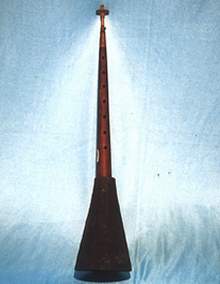
World Flutes Master

Take care of our enviroment

comprar

Peace web theme set courtesy of Crystal Cloud Graphics web set icon
Crystal Cloud Graphics
Crystal Cloud Graphics

Pi Le
Pi Le is a wind instrument with double reed of Thai people in Phong Tho district of Lai Chau province.
Pi Le consists of 4 components including body, bell, reed, and stake. The body is a cylindrical hollow hard-wooden tube, on which, there are 8 fingering holes, of which, 7 holes are at front side of the body and arranged in line along the body by equal distance, while the eight hole is located towards the reed stake and at the back side of the body. The wooden bell is made thin and has a shape of a cut-off pyramid. The small end of the bell is connected with the body whose the small end is placed with the reed stake. Being put into the stake is either reed-stem or worm-nest reed.
Range of Pi le comprises 2 octaves including Do (perfect) - Re (tender) - Mi (tender) - Fa (hard) - Sol (perfect) - La (tender) - Si (tender) - Do1 (perfect). When playing, instrumentalist holds in his mouth the whole reed, and takes breath at his nose and breathes out at mouth forcing air into the reed. By such a blowing way, the instrumentalist can play for hour and hour without breaking-off of his breath. The techniques applied to playing vary from this musical piece to another piece but usually consist of tongue techniques like flutter-tongue, tongue articulation, and glissando, and fingering techniques like appogiatura, glissando, and vibration with tremolo.
Pi Le is the exclusive instrument played by men in customary ritual orchestras of Thai people. Especially, Pi Le is commonly used in funeral music. Pi Le is usually performed in ensemble with cymbals, flat gongs of small and large sizes, and drum. It is said that sounds of Pi le are indispensable to solemn and sacred customary rituals of Thai community.
Pi Le is a wind instrument with double reed of Thai people in Phong Tho district of Lai Chau province.
Pi Le consists of 4 components including body, bell, reed, and stake. The body is a cylindrical hollow hard-wooden tube, on which, there are 8 fingering holes, of which, 7 holes are at front side of the body and arranged in line along the body by equal distance, while the eight hole is located towards the reed stake and at the back side of the body. The wooden bell is made thin and has a shape of a cut-off pyramid. The small end of the bell is connected with the body whose the small end is placed with the reed stake. Being put into the stake is either reed-stem or worm-nest reed.
Range of Pi le comprises 2 octaves including Do (perfect) - Re (tender) - Mi (tender) - Fa (hard) - Sol (perfect) - La (tender) - Si (tender) - Do1 (perfect). When playing, instrumentalist holds in his mouth the whole reed, and takes breath at his nose and breathes out at mouth forcing air into the reed. By such a blowing way, the instrumentalist can play for hour and hour without breaking-off of his breath. The techniques applied to playing vary from this musical piece to another piece but usually consist of tongue techniques like flutter-tongue, tongue articulation, and glissando, and fingering techniques like appogiatura, glissando, and vibration with tremolo.
Pi Le is the exclusive instrument played by men in customary ritual orchestras of Thai people. Especially, Pi Le is commonly used in funeral music. Pi Le is usually performed in ensemble with cymbals, flat gongs of small and large sizes, and drum. It is said that sounds of Pi le are indispensable to solemn and sacred customary rituals of Thai community.

Text and Photos courtesy by Vietnam Datacommunication Company (VDC)
and Vietnamese Institute for Musicology (V.I.M)
and Vietnamese Institute for Musicology (V.I.M)








